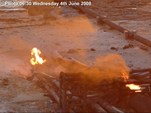On 8 June 2008, a US 60 Minutes report on combustible dust joined the conga-line of critics of the Occupational Safety And Health Administration. The tone of the report is set by the reporter, Scott Pelley’s introduction stating that it is OSHA’s responsibility to avoid the explosions. For OHS practitioners and professionals this is a peculiar statement as it is usually the employer’s responsibility for workplace safety.
The 60 Minutes report illustrates the difficulty that OHS inspectors face when visiting workplaces. Can an inspector be expected to identify ALL the hazards present in a workplace? This is a constant problem for OHS regulators, employers and sadly, the Courts.
The accusation in the 60 Minutes report is that inspectors had no information or training on the explosive hazards of dust. Training is not the solution for everything and an inspector’s state of knowledge should have identified dust as a potential hazard. Even if the hazard was identified in terms of an inhalation risk, or housekeeping, the explosive risk would be reduced if housekeeping was applied properly.
OSHA clearly stated the responsibility of workplace safety being on the employers. The missing element of the entire 60 Minutes report is that the site operators and employers who have experienced dust explosions were not interviewed.
More information on the February 2008 explosion at the Imperial Sugar plant mentioned in the report is available by clicking HERE
For those of you who find dust explosions exciting a video of a dust explosion in a silo is available HERE
For those employers or inspectors who did not do high school science, a schoolroom example of the combustible hazards of dust can be found HERE


